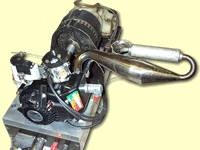
You can build a basic Engine Dyno or dynamometer to help you test the efficiency of your engine in a few steps. This is not a simple process, but with attention to detail and some skills with basic tools, these instructions will help you build a working Engine Dyno.
Mount your engine in the engine stand. Secure the engine with the attaching hardware, tighten all nuts to the specified torque on the hardware instructions.
Take both your multimeter and tachometer and arrange them on the engine so that the probes of each can easily reach several locations on the engine: glo plugs, headers and flywheel. Now using the punched metal framing rods and the car exhaust support straps, construct a small support for each meter that will hold the meter firmly above the engine and still allow the probes to reach.
Using the electrical tape, temporarily coil and attach the probes to their support frames away from any contact with the engine and out of reach of any moving parts. Start the engine and let it run for 5 or 10 minutes. Turn the engine off and test the attachment of the meters to make sure they are still secure. Adjust the attachment if necessary.
Attach your servo motor to your accelerator control. Run the engine again and test that the servo will adjust the acceleration properly. Make a note of the accelerator settings you will want to use for your tests. Once you have done this, turn the engine off and you are ready to connect your Engine Dyno.
Attach the probes of each meter. For the Fluke multimeter you will want to attach the probes to the engine glo plug and header, as well as any other place on the engine where the sensor will be able to detect the temperature of the engine. Aim the sensor probe of the tachometer at the flywheel of the engine.
Run the engine for a predetermined amount of time. While the engine is running, record the readings from your tachometer and multimeter as well as the accelerator setting at which you took these readings. Some multimeters allow for the data to be directly entered into a PC spreadsheet. You can then pick 2 parameters to form a dataset and form your graph to gain results from your specific test.